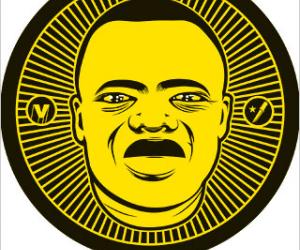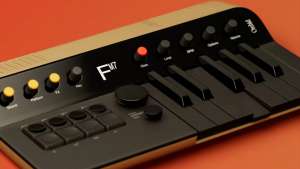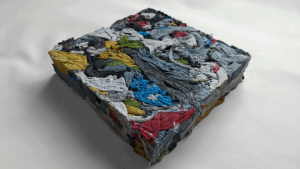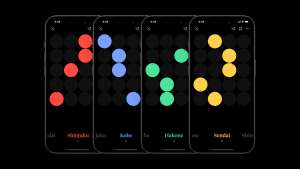
The third and last day of the Toffie Festival conference started on a very highfalutin note with Cape Town artist Francis Burger. Interested in the practice of art, as well as the theory and philosophy, Burger says that her projects are often motivated simply by the desire to research. Dropping names like Gilles Deleuze, Jacques Lacan, Frederik Jameson and Pierre Boulez lost more than a few of the audience along the way, but she apologised at the end saying that “I write very good essays”.

Burger was followed by the super cool dancer, rapper, illustrator and graphic designer Smiso Zwane from Dirty Paraffin who is headlining the Sailors and Secretaries Afterparty tonight. Despite his multifarious talents, Zwane’s imagination has been captured by the accessibility of video in an era of Smartphones and Macbooks.
“Joburg has the SABC and Cape Town has the internet; Joburg is America and Cape Town is Europe,” explained the Durban-born creative. “So I decided I wanted to show the world a bit of what’s in between Joburg and Cape Town, a bit of Durban.” Having already been picked up by Fader magazine, I’m putting my money on Zwane being the next DJ Mujava / Blk Jks / Spoek Mathambo / Die Antwoord phenomenon.
In his nonchalant manner, Zwane also summed up the undercurrent of the entire Toffie Festival: “Even though I hold down a nine-to-five, I’ve never been stopped by a lack of money or time.” That blind obsessive passion for fulfilling one’s creative potential and sheer stubborn curiosity came through in almost every presentation over the past three days, especially in Zwane and the three speakers who followed today: Jonathan Puckey, Alex Trochut and Daito Manabe.

Hailing from the Netherlands, Jonathan Puckey explained up front that he does two types of work: Makes his own tools and sets up systems. Saying that Adobe has become a dictator of the potential of graphic design, Puckey’s “tools” are born out of a frustration of what can’t be done. Mostly his tools are built using Scriptographer by Jürg Lehni, who spoke yesterday. His tools include Text Pencil, which allows you to draw with text; Lettering Tool, which allows you to have different shaped letters in a single font; and the Delaunay Raster Tool, which uses a mathematical formulae to raster pictures into triangles, allowing one to create portraits from very low-res images.
Puckey explained that by creating a tool, one can synthesise multiple little decisions into a single motion, meaning that you solve half the problem up front allowing one to simply design thereafter. This maxim can especially be seen in his tools that allow one to easily draw multiple, different-sized but regular clouds, fences, roads and cigarettes.

The distinction between a “tool” and a “system” was not always clear with Puckey as seemingly all of his projects were initially conceived of as systems and solved using tools. Such as the PDF annual report that he did for a small Dutch museum that had international ambitions. The whole report was written in Dutch, which seemed ironic to Puckey considering their global ambitions. So he turned to Amazon’s Mechanical Turk, which is a system that employs real human beings to do mundane digital tasks. Using only English-speaking people who could not understand Dutch, he gave each of them a part of the report to translate into English and forbade them to use Babelfish or any dictionary. They then recorded themselves reading their translations and the recording was embedded in the PDF. Listen and read here for hilarious results – especially for a South African audience that does have some grasp on the Dutch original.

Another of his system/tools, followed all the changes that the Fox News website made to their stories over time – The Quick Brown is one of the best visualisations of how the news is fabricated I’ve ever seen. Also exploring the slipperiness of time and content on the internet, his One Frame of Fame music video for C-Mon & Kypski regenerates every hour. First they filmed the music video and broke it down into 1200 frames. The frames were posted onto the internet and the world was invited to upload a picture of themselves mimicking the frame.
Although Puckey works predominately in the digital realm, he hates to be pigeonholed as a “digital designer”. As such he and three other designers initiated www.conditionaldesign.org, which started as a discussion about what their work has in common and ended up as a manifesto. The manifesto is hinged on the fact that they are more interested in designing processes or rules that result in a product, rather than reproducing a product that is preconceived by the mind.

Alex Trochut, on the other hand, warned against creating rules that are too strict to follow, but also introduced the audience to his grandfather, Joan Trochut who invented the Super Tipo Veloz lead type design system in the early 20th century. Super Tipo Veloz is a limited system of shapes that allowed printers to construct numerous different typefaces and even illustrations. It was used widely for about 20 or 30 years before offset printing was invented and it disappeared into the annals of history.

Labelled “the world’s leading typographer” in the programme Trochut was quick to dismiss this superlative and explain that he is not a typographer but a “digital craftsman”. He went on to show his work and, very impressively, shared all the different stages of experimentation that ultimately led to the final work. It was through these different stages that it became clear how much influence his grandfather’s systems of reductive, simplified shapes have on his work. He drew lots of oohs, aahs and spontaneous applause through his sheer creative rigour, perseverance, attention to detail and, of course, the gob-smacking end result.

So self-reflexive, Trochut is the first designer that I’ve ever heard say that sometimes the client’s changes do lead to a better final product. “The more you try, the more chances you have of getting lucky, of making a mistake that works,” he said near the end of his presentation before sharing his “experience map”. The map connected all of his work, showing how one solution enabled him to complete the next design in a brand new way.

Ending off the day’s talks was the highly anticipated artist, sound designer, programmer, DJ and VJ Daito Manabe from Japan. With a background in mathematics and engineering, and a Japanese translator to boot, Manabe was sometimes hard to follow however the potency of his work spoke for itself. Manabe is one of those designers who proves that often creativity comes from the other side of sanity and completely inspires you by making you realise how pathetic you are in comparison!
Giving a neat little definition of design as being about “finding a solution using limited means”, Manabe explains his philosophy as making something new out of the traditional and conventional. When that “something new” ranges from turning his body into a musical instrument or literally making the world’s first air guitar, to creating LED mouthpieces that light up people’s teeth in different colours or Nike shoes that can be played like musical instruments, it’s hard to still recognise what the traditional and conventional origin was!
Utterly mind-blowing however was his design that allows him to digitally transfer his facial expression to another person. Seriously, it’s too synchronised to be faked. After having the initial idea, he set up a set of facial sensors that could control sounds when the face was moved. Once that was perfected, he reversed the process, making the sounds control the muscle sensors, causing facial movements. Then he connected the two systems – he made the facial expressions that made the sounds that tweeked the muscles sensors on his friends.
To say it neatly: Manabe has made it literally possible to design a smile. Thanks Toffie, I’m smiling!







